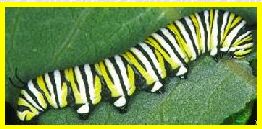 Lesson 3:
Lesson 3:
 The Essence of Life
The Essence of Life
|
 3.5
3.5
 Environmental Limits Of Life
Environmental Limits Of Life

|
 |
 |
Figure 3.5.1
 Monarch caterpillar and Monarch butterfly.
Monarch caterpillar and Monarch butterfly.
|
To be alive is to change. It is true that there exist resting stages of
living things that do nothing, as far as we can tell, for thousands of
years and are still viable after the experience. Such resting stages
include bacteria deep within the Earth, spores of dinoflagellates and
diatoms, plant seeds, dried out tardigrades (equidistant cousins of
earth worms and centipeds). However, we do not count these organisms
among the living because they rest, but because they come alive and
change when the time is ripe, that is, when the environment is
favorable.
A favorable environment invariably includes the availability of water.
Why should this be so? Well, first of all, change (growth, maturation,
reproduction) implies chemical reactions, that is, break-up and
re-assembly of molecules. Such reactions take place within liquids. They
cannot proceed when an organism is desiccated or frozen. Reaction in the
gas phase is excluded because temperatures would be too high for the
delicate molecules of life to survive. While the surfaces of solids are
a good place to rearrange molecules, there must be a way to bring the
molecules to the surfaces in the first place, to sustain the reaction.
(A football stadium is a good place to arrange the seating of fan clubs,
but offsite transportation is necessary for a stadium to fill and to
empty.) In a cell, the necessary mobility is delivered by liquid water.
The fact that many more fundamentally different types of organisms live
within water than live outside of water suggests that life originated in
a watery environment and only later invaded dry land, inventing
mechanisms for coping with the limited supply of water.
Granted that life-sustaining reactions have to take place within a
liquid, why should that liquid required to be water, rather than liquid
ammonia or liquid carbon dioxide or some liquid organic compound (as
seen in petroleum, for example)? Why water? In fact, we cannot exclude
the possibility that other liquids besides water can play a role in
sustaining life processes. Carbon dioxide is out, because its stability
range for being liquid is too narrow (it tends to be either gaseous or
solid). But water is special. It has a number of properties that make it
an ideal solvent, capable of holding and transporting molecules. Perhaps
the most important is the electric polarity of single water molecules,
with the two hydrogen atoms to one side of the oxygen atom. This makes
for the presence of weak binding forces which keep the water liquid and
provide for ways to envelope the molecules to be transported.
 |
 |
Figure 3.5.2
 The individual water molecule (on the left)
The individual water molecule (on the left)
is composed of two hydrogen atoms and one oxygen atom.
The oxygen end of the molecule is negatively charged.
The two hydrogen atoms bear a slight positive charge.
This separation of charge within the molecule is called
"polarity", and the molecule is said to be "polar". Because
water is a polar molecule, it "sticks" to itself and has
special properties. The positive end of one molecule is
electrically attracted to the negative end of another
water molecule. |
Besides,
water is very abundant. Hydrogen is the single most abundant element in
the universe. The nucleus of the oxygen atom is made of precisely four
helium nuclei, a very stable arrangement. Thus, oxygen also is very
abundant. It seems unlikely, therefore, that water would not be present
if other liquids are present on a planetary body at a temperature that
is acceptable for the existence of reactive organic molecules (made of
carbon, hydrogen and oxygen). One interesting liquid to study for its
potential as a host for life is an intimate mixture of water and
ammonia. It does not freeze until the temperature drops below -100oC.
The fact that we need a liquid environment for life's chemical reactions
greatly limits the acceptable temperature range. At standard atmospheric
pressure, water is liquid from 0oC to 100oC. (This is how the centigrade
scale is defined: 100 degrees between freezing and boiling.) With
increasing pressure, the boiling point moves to higher temperatures. As
long as the water stays liquid, certain life forms can deal with high
temperature. Extremophile bacteria and archea are abundant at deep-sea
vents at water temperatures up to 300oC. They make a living as
chemo-autotrophs, using chemical disequilibria between seawater and
basalt in the vent environment as an energy source. They also provide
food for the vent communities. Similar microbes are found in hot springs
on land, albeit at lower temperatures (the pressures are not great
enough to keep the water from boiling at 100oC).
Water stays liquid at high pressures; this fact allows living organisms
to thrive right at the bottom of the deepest trenches, at pressures a
thousand times greater than at sealevel. (That there are no more
creatures down there has more to do with the lack of food than with the
high pressure.) At very low pressures and low temperatures water either
exists as ice or as vapor, but not in liquid form. This is why we should
not expect to find active life on Mars today - the pressure is too low
for liquid water. Of course, this does not exclude finding fossil
leftovers from a distant warmer period, when water may have been flowing
on Mars. Apparently, resting stages (typically de-watered) can survive
the zero pressure conditions in space: bacteria exposed on Apollo
spacecraft and subsequently recovered were found viable. However, they
can do nothing during their vacuum exposure other than wait for better
circumstances, that is, conditions providing for liquid water.
Do you like salt herring? Salting the herring was invented in the Middle
Ages as a solution to the problem of how to get herring to shore and to
customers before it disintegrates from bacterial attack. Salt, on the
whole, is inimical to bacterial proliferation. We have some trouble with
salt ourselves: we cannot use seawater as drinking water. Drinking too
much of it makes us very sick. Since our fish-like ancestors left the
sea some time ago (400 million years or so) we have lost the ability to
deal with so much unwanted salt - our kidneys cannot handle it. Marine
organisms, of course, do just fine. But what about salt brine? Is it
entirely inaccessible to living things? Well, no. There are brine shrimp
and there are brine beetles populating the brine pools in the deserts of
California. They do not seem to mind. But is there life in really
concentrated brines? What about the Dead Sea? Yes, even so and despite
its name. There is a class of microbes called "halophiles" (salt lovers)
that can easily tolerate high salt density. In fact, because every one
else is kept out of the habitat, they have the place to themselves and
thrive.
Liquid water has some other ingredients, some of them potentially a lot
more nasty than salt. Even so, some living organisms make a specialty
out of coping with such (for us) unpleasant environments. Take sulfurous
brines, or highly acidic or alkaline environments. Almost invariably,
given an energy source, there is some archean life form growing in this
stuff. One organism has been found thriving in the tanks of nuclear
reactors! Thermococcus radiodurans can take a dose of radiation 10,000
times greater than that which is lethal to other organisms. How does it
manage? How did it ever evolve the ability to do so when that level of
radiation does not exist in nature? Perhaps it has learned, earlier, how
to cope with some other disruptive process and has transferred these
skills to coping with the effects from radiation.
The lesson from this survey of life's environment is simple. If there is
a place not taken, where a living can be made, Life will find a way to
grasp the opportunity. However, it is doubtful that Life could originate
under the conditions which it can tolerate or conquer once it exists.
Presumably, conditions for the origin of life are much more restrictive
than the conditions acceptable for the expansion of life.
|





















